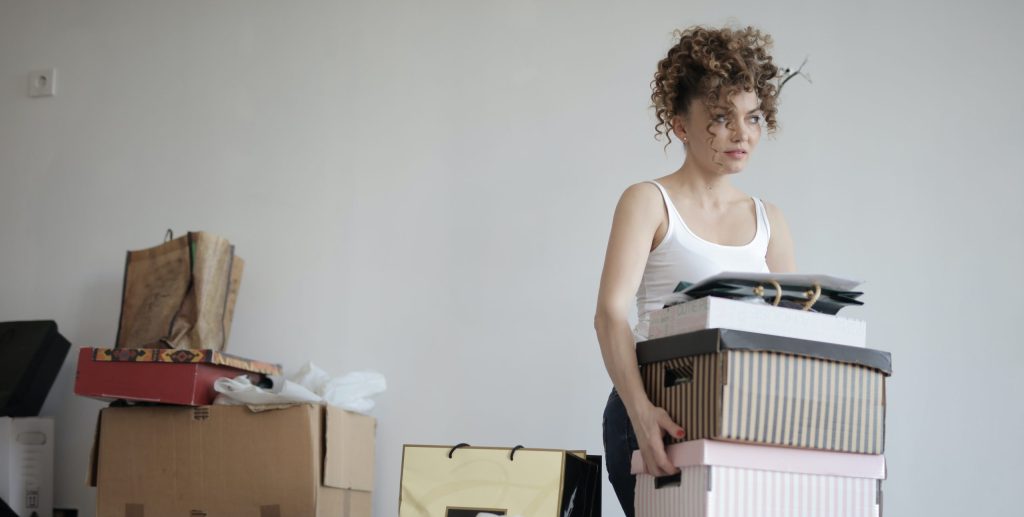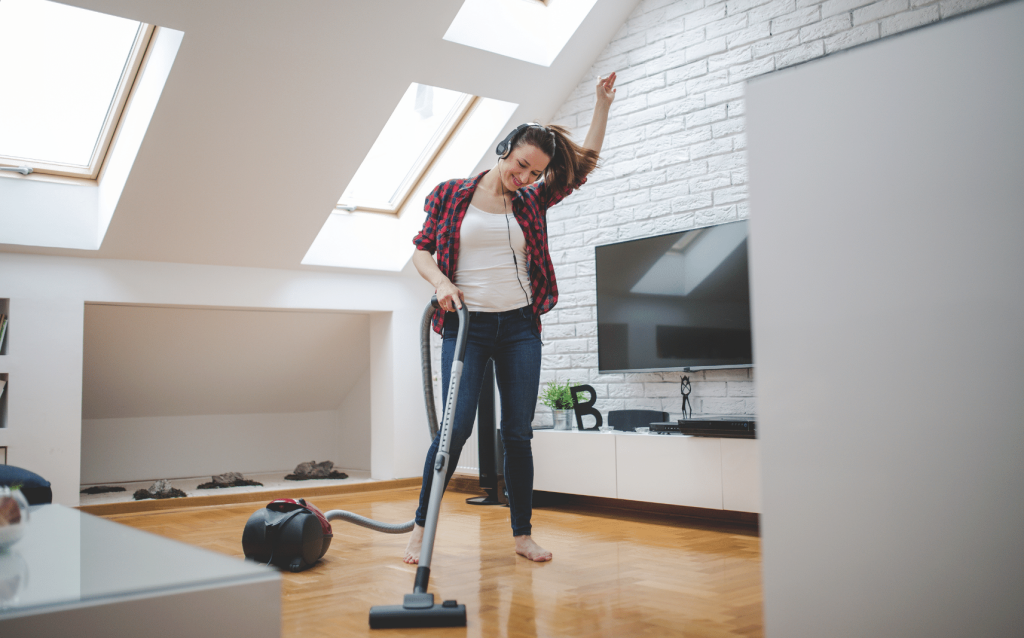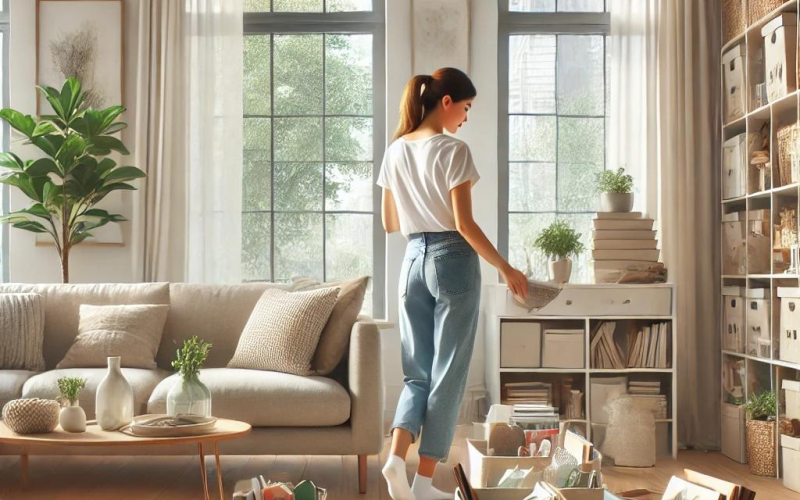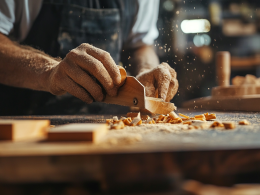Sarah Thompson, a 35-year-old marketing executive, never imagined she’d become a minimalist. Her three-bedroom suburban home in Austin, Texas, was a testament to years of accumulation—closets overflowing with clothes she rarely wore, kitchen drawers jammed with gadgets she barely used, and a garage so packed she couldn’t remember the last time she parked her car inside.
According to a study by the National Association of Professional Organizers, the average American home contains 300,000 items. Sarah’s home was no exception. “I was drowning in stuff,” she recalls. “Every surface was covered, and every drawer was full. It was overwhelming.”
But one day, everything changed. This is the story of Sarah’s extreme decluttering journey and the unexpected lessons she learned along the way, a tale that resonates with many in our consumer-driven society.
The Turning Point
A Wake-Up Call
It was a typical Saturday morning when Sarah tripped over a stack of unread magazines in her living room, spilling her coffee all over her favorite Persian rug. As she stood amid the chaos, something inside her snapped. “I can’t live like this anymore,” she thought. That moment marked the beginning of her minimalist journey.
“I realized I was spending more time managing my possessions than enjoying my life,” Sarah explains. “It was like a lightbulb moment. I knew something had to change.”
Embracing Minimalism
Determined to make a change, Sarah began researching minimalism and decluttering techniques. She discovered popular methods like Marie Kondo’s KonMari method, which encourages keeping only items that “spark joy,” and the Swedish Death Cleaning approach, which involves decluttering as if preparing for the end of life.
Sarah says, “I found the notion that less could actually be more to be fascinating.” She made the decision to start her own extreme decluttering adventure after reading about others who had successfully done so and taking inspiration from these ideas.
Dr. Emily Johnson, a psychologist specializing in home environments, notes, “The decision to declutter often comes from a deep desire for change. It’s not just about organizing things; it’s about reclaiming control over one’s life and space.”
The Decluttering Process

Starting Small
Following the advice of many decluttering experts, Sarah started with her closet. She emptied everything onto her bed and, following Marie Kondo’s advice, only kept items that “sparked joy.”
“I was shocked to find that over half of my clothes didn’t make the cut,” Sarah recalls. “I hadn’t worn most of these things in years. Some still had price tags on them!”
This initial purge resulted in eight bags of clothes for donation. According to the Council for Textile Recycling, the average American throws away 70 pounds of clothing and other textiles annually. Sarah’s closet cleanout alone nearly matched that figure.
Tackling Bigger Challenges
As she moved through her house, room by room, Sarah faced bigger challenges. The kitchen, filled with duplicate utensils and gadgets she never used, took a full weekend to sort through.
“I found five can openers,” Sarah laughs. “Who needs five can openers?” She also discovered appliances she’d forgotten she owned, still in their original packaging. This experience aligns with a report from the National Kitchen and Bath Association, which found that 60% of kitchen items are rarely or never used.
The garage was an even bigger task, requiring a dumpster rental to handle the sheer volume of items she decided to let go of. “I hadn’t seen the floor of my garage in years,” Sarah admits. “It was like an archaeological dig.”
Emotional Hurdles
One of the toughest aspects of decluttering was dealing with sentimental items. Sarah found herself holding onto things not because she needed them, but because of the memories attached.
“I had boxes of my children’s artwork, every birthday card I’d ever received, and souvenirs from trips I barely remembered,” she says. “I had to learn to separate the memory from the object. I realized I could keep the memory without keeping the physical item.”
Dr. Johnson explains this common struggle: “Objects can become imbued with emotional significance. Learning to let go of these items while holding onto the memories they represent is a crucial skill in decluttering.”
Sarah found creative solutions, like photographing special items before letting them go and creating a digital scrapbook of memories.
The Dumpster Rental Experience

A Necessary Step
As Sarah’s decluttering efforts intensified, she realized she needed a way to remove large amounts of items quickly. She decided to rent a construction dumpster, which turned out to be a game-changer in her minimalist journey.
“At first, I was hesitant about the dumpster rental,” Sarah admits. “It seemed so extreme. But once I started filling it, I realized how necessary it was.”
The Environmental Protection Agency reports that the average American produces about 4.9 pounds of waste per day. Sarah’s decluttering process temporarily increased her waste output, but she was mindful about donating and recycling as much as possible.
Unexpected Treasures
During the process of filling the dumpster, Sarah made some surprising discoveries. She found old photo albums she thought were lost, a valuable vintage watch that had belonged to her grandfather, and even some cash stashed away in an old book.
“It was like a treasure hunt in my own home,” Sarah laughs. “I found things I’d completely forgotten about. It made me realize how little I actually knew about what I owned.”
This experience is not uncommon. A survey by Pixie Lost Item Finder found that the average American spends 2.5 days a year looking for lost items. By decluttering, Sarah was not only freeing up space but also rediscovering forgotten possessions.
Surprising Lessons Learned
Financial Insights
One of the most unexpected outcomes of Sarah’s decluttering journey was the impact on her finances. “I realized how much money I had wasted on things I didn’t need or use,” she says. This awareness led to more mindful spending habits and significant savings.
Sarah started tracking her expenses and was shocked to find that she had been spending an average of $400 per month on non-essential items. “It was eye-opening,” she says. “I realized I could redirect that money towards experiences or savings instead of more stuff.”
Financial expert John Smith notes, “Decluttering often leads to a reassessment of spending habits. When people realize how much they’ve spent on unused items, it can be a powerful motivator for change.”
Psychological Benefits
As her space became less cluttered, Sarah noticed her mind felt clearer too. “I didn’t realize how much mental energy I was expending just managing all my stuff,” she explains. She found herself less stressed and more focused on what truly mattered to her.
This aligns with research from the University of California, Los Angeles, which found that clutter can increase cortisol levels, a hormone associated with stress. By decluttering, Sarah was literally creating a less stressful environment for herself.
“I sleep better, I’m more productive at work, and I feel more creative,” Sarah says. “It’s like removing the physical clutter also removed mental clutter.”
Environmental Awareness
The process of decluttering opened Sarah’s eyes to the environmental impact of consumerism. She became more conscious of her purchasing decisions and started exploring eco-friendly living and zero waste practices.
“Seeing how much stuff I was getting rid of made me think about where it all ends up,” Sarah explains. “I started researching ways to reduce my environmental impact.”
Sarah began composting, switched to reusable shopping bags, and started buying more items secondhand. According to the Ellen MacArthur Foundation, extending the life of clothes by just nine months reduces their environmental impact by 20-30%.
Life After Decluttering

New Daily Habits
Sarah’s newly decluttered home required new habits to maintain. She adopted a “one in, one out” rule for new purchases and implemented daily tidying routines to prevent clutter from accumulating again.
“It’s not about never buying anything new,” Sarah explains. “It’s about being intentional with what I bring into my home.” She now asks herself three questions before making a purchase: Do I need it? Will I use it regularly? Do I have a place for it?
Sarah also implemented the “10-minute tidy” – spending 10 minutes each evening putting things back in their place. “It’s amazing how much you can accomplish in just 10 minutes,” she says.
Improved Relationships
With less time spent managing her possessions, Sarah found more time for relationships. “I started having friends over more often,” she says. “I wasn’t embarrassed about my home anymore, and I had more energy for socializing.”
Sarah also found that her relationships with family members improved. “We used to argue about the mess,” she recalls. “Now that’s not an issue anymore. We can focus on enjoying each other’s company instead.”
Shifted Perspective on Consumerism
Perhaps the most profound change was in Sarah’s attitude towards shopping and owning things. “I used to think having more stuff would make me happier,” she reflects. “Now I know that less really is more.”
This shift in perspective aligns with research on happiness and materialism. A study published in the Journal of Consumer Psychology found that experiences tend to provide more lasting happiness than material possessions.
Sarah now focuses on experiences rather than things. “Instead of buying new clothes, I might save for a weekend trip with friends,” she explains. “I’ve found that these experiences bring me much more joy than any purchase ever did.”
Tips for Aspiring Minimalists
Start Small
Sarah advises those interested in minimalism to start with small, manageable areas. “Don’t try to declutter your entire house in a weekend,” she warns. “Start with a drawer or a closet and build from there.”
She suggests setting a timer for 15 minutes and focusing on one small area. “You’d be surprised how much you can accomplish in 15 minutes,” she says. “And it’s less overwhelming than trying to tackle everything at once.”
Maintain Your Progress
Maintaining a clutter-free lifestyle requires ongoing effort. Sarah suggests regular “maintenance decluttering” sessions to keep things in check.
“I do a quick sweep of my home every month,” she explains. “I look for items that aren’t being used or that no longer fit my lifestyle.” This regular maintenance prevents clutter from building up again.
Be Kind to Yourself
Decluttering can be an emotional process. Sarah emphasizes the importance of being patient and kind to yourself. “It’s okay to keep some sentimental items,” she says. “The goal is progress, not perfection.”
Dr. Johnson agrees: “Decluttering isn’t just about getting rid of things. It’s about creating a space that supports your well-being. That might mean keeping items that have deep personal meaning, even if they don’t serve a practical purpose.”
Sarah suggests creating a ‘memory box’ for special items that you’re not ready to part with. “I have a small box where I keep particularly meaningful mementos,” she explains. “It allows me to honor those memories without letting them take over my space.”
Final Thoughts….
Sarah’s journey from clutter to minimalism was full of surprises, challenges, and valuable lessons. While she never expected a dumpster rental to play a role in transforming her life, it became a symbol of her commitment to change. Today, Sarah enjoys a simpler, more intentional lifestyle.
“I don’t miss the stuff,” she says. “I gained so much more by letting go.” Her home, once a source of stress and embarrassment, is now a peaceful sanctuary. “It’s not about having a picture-perfect home,” Sarah explains. “It’s about creating a space that supports the life you want to live.”
Sarah’s story is not unique. According to a survey by the National Association of Professional Organizers, 54% of Americans feel overwhelmed by clutter, and 78% have no idea what to do with it. Her journey offers hope and practical advice for those looking to make a change.
Remember that every person’s path to minimalism is different for those who find inspiration in Sarah’s story. Whether you’re looking to make a dramatic change or just want to declutter a bit, the path to a simpler life starts with a single step—or, in Sarah’s case, a single dumpster.
“Start where you are,” Sarah advises. “You don’t have to declutter your entire life overnight. Small changes can lead to big results over time.”
As more people like Sarah embrace minimalism, it’s clear that the movement is about more than just tidying up. It’s about reassessing our relationship with material possessions and finding ways to live that align with our values and priorities.
“Minimalism isn’t about deprivation,” Sarah concludes. “It’s about making room for what truly matters. And that’s different for everyone.”
Whether you’re drowning in clutter or just looking to simplify your life a bit, Sarah’s story offers valuable insights and inspiration. It shows that with determination, creativity, and maybe a dumpster rental, it’s possible to transform not just your space, but your entire way of living.
For readers interested in starting their own decluttering journey, Sarah recommends the following resources:
- “The Life-Changing Magic of Tidying Up” by Marie Kondo
- “Goodbye, Things: The New Japanese Minimalism” by Fumio Sasaki
- The Minimalists podcast
- Local professional organizers or decluttering services
Remember, the goal isn’t to copy someone else’s version of minimalism, but to create a space and lifestyle that work for you. As Sarah’s story shows, the journey to minimalism can be full of surprises, challenges, and rewards. The key is to start somewhere and stay committed to the process.
By embracing minimalism, you might just find, like Sarah did, that less truly is more.











